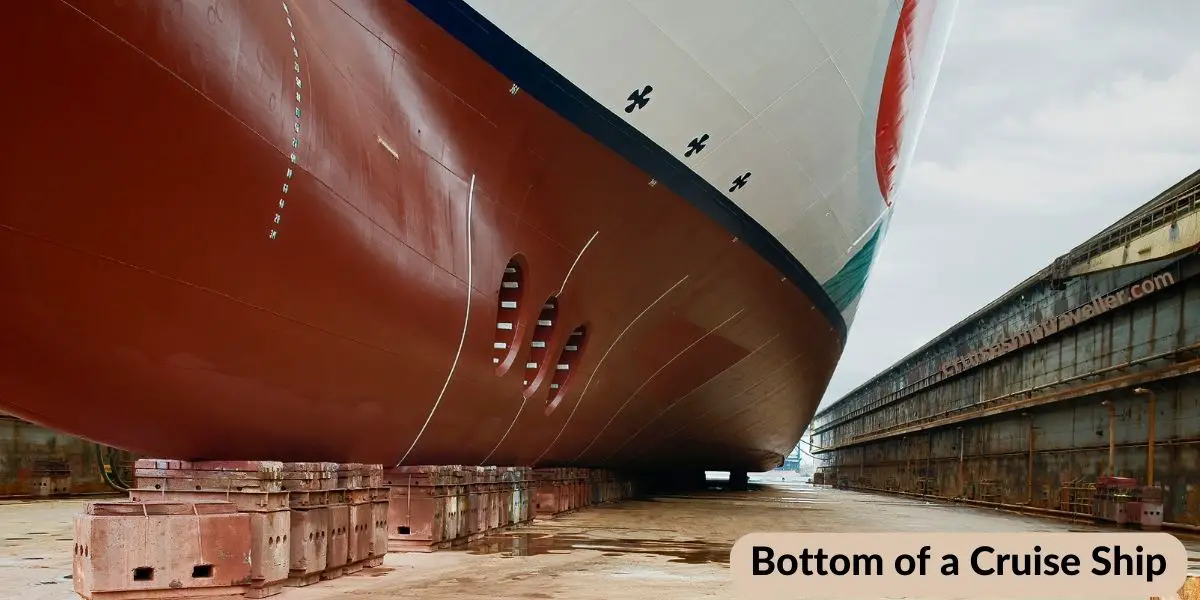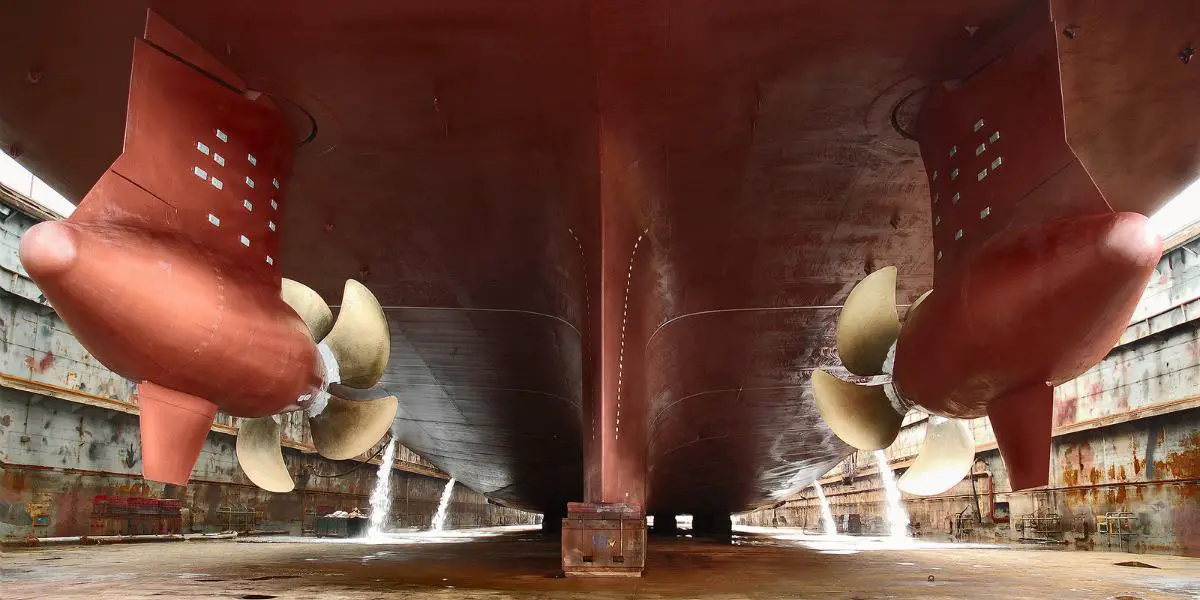The bottom of a ship is generally referred to as the hull.
However, the hull is made up of various parts and features, which all have their role to play in keeping the ship afloat and able to sail safely.
As you will see, the front of the bottom of the ship is very different from the stern (the back).

Bottom Parts of a Cruise Ship
On such massive vessels, there are various prominent parts to the bottom of a cruise ship.
We take a look at each of the main parts below.
Hull
When people refer to the bottom of a cruise ship, they are primarily referring to the hull.
The hull is the water-tight lower body of the ship. It is the part that extends down into the water and upwards to the lower decks of the ship
Cruise ship hulls are made from hundreds of steel panels all welded together and carefully smoothed over to be as smooth as possible.
Large ocean-going cruise ships have U-shaped displacement hulls designed to push water aside as it moves forwards and keeps the cruise ship afloat. The width of the hull acts as a stable base, especially in rougher seas.
Keel
The keel of a ship is the bottommost structural part of the ship which runs from the bow to the stern along the centerline.
Bilge Keels
Blige keels are on either side of the bottom of the cruise ship. These nautical devices run parallel to the keel and act to reduce the ship’s ability to roll on either side in the water.
Bulbous Bow
Often, the very bottom front end of the cruises ship is a bulbous bow. This is a large rounded projection designed to reduce the ship’s drag. It does this by changing the way the waves move along the hull.
This results in the ship’s lower fuel consumption.

Are Cruise Ship Bottoms Flat?
The majority of cruise ships’ bottoms are flat, although not completely flat all the way along.
A wide flat bottom makes the vessel more stable, which is essential for minimizing any movement or rocking on the ship, which is crucial for a vessel carrying passengers.
They are not so flat at the bow or the stern. The bow narrows into a projecting bulbous bow.
Whereas at the stern, the rear is raised in the area above the ship’s propellers as you can see in the photo below.

What Shape is the Bottom of a Cruise Ship?
The bottom of a cruise ship is normally designed in either a U-Shape or a V-shape, depending on which water conditions they will typically be sailing in.
The keel is broad and flat along the majority of the bottom of the cruise ship.
Towards the aft of the ship, the bottom rises above where the propellors are placed and broaden out into a more squarish shape at the stern.
Why is the Bottom of a Cruise Ship Red?
When ships were traditionally made of wood, the part of the cruise ship that’sunder water, the hull, was painted with copper paint or covered in some cases covered, with copper sheets.
This copper coating, which looked reddish in color, was to protect the hull from anything which might degrade it over time, most commonly worms eating into the wood.
There was also the benefit of preventing all kinds of barnacles, seaweeds, algae, and other microorganisms from attaching themselves to the bottom of the hull and, over time, adding weight to the ship.
This build-up of biological fouling (epibosis), can, over time, damage the protective paint and metal structures of the bottom of the ship.
Also, when foreign objects accumulate on the hull as well as adding weight to the ship, they act to increase the ship’s drag, thereby slowing the ship down and increasing the ship’s fuel consumption.
These factors might seem minor, but over the course of thousands of miles a year, the extra costs can be quite significant.
So while these days, many different colors of paint can be used to serve the same purpose it is now simply a nautical tradition to keep painting the hulls of ships red.
Anti-fouling
Modern cruise ships are made of steel, so there’s a danger of being eaten by worms, but there’s still the possibility of growth and barnacles attaching to the hull and reducing the smooth streamlined surfaces of the hull.
To prevent this, the metal hulls are painted with an anti-fouling paint, which contains copper which acts as a coating of biocide. Modern anti-fouling paints contain mostly contain cuprous oxides.
Due to the chemicals used with the anti-fouling copper oxide paints, cleaning the bottom of cruise ships is not allowed, as this would remove some of the paint and chemicals as well as potentially remove invasive sea plants and other microorganisms attached to the ships hull which could damage local ecosystems.
What Does the Bottom of a Cruise Ship Look Like?
A good way to see what the bottom of a cruise ship looks like is to look at videos and see the underneath from various angles.
After doing some research, I found some of the best videos with clear views of the very bottom of cruise ships.
Some are filmed from directly underneath the vessels in dry docks, as well as from other angles, to give you the best understanding of every aspect for the full length of the bottom of the ship.
In case you are wondering, we have covered here how cruise ships get launched into the water, from being in a dry dock.
Videos Underneath a Cruise Ship
The best way to see the bottom of a cruise ship is to get underneath it when it’s in a dry dock.
Underneath Regal Princess
The video below shows the bottom of the Regal Princess cruise ship, in Palermo, Italy.
In it, we can see footage right underneath the cruise ship.
0.45 & 1.07: You can start to make out the thin fin-like blige keels as the camera moves towards them.
1.00: Under the stern are the ship’s propellors
1.36: Is the ship’s huge anchor, freshly painted blue, behind which you can see three bow thrusters. Also, notice how flat the supported keel is.
1.40: The bulbous bow projecting forward from the bottom of the ship.
The Bottom of Grand Princess Cruise Ship
This amateur footage takes a look at the underside of the Princess Cruise, Grand Princess while in a dry dock for repair work.
They manage to get right under the ship provide a great view of how broad and flat the bottom of the ship is.
You can see this from viewpoint angles at 0.51 seconds and at 2.06 m they walk under the bilge keels directly beneath the ship’s hull.
At 3.43m you can see a fin stabilizer tucked into the ship’s hull. The fin stabilizer extends out further than the bilge keels, and unlike bilge keels, the angle of the fin can be changed to counter the force of the waves that are potentially going to cause the cruise ship to tip over.
At 5.07 you can see the Bulbous bow, and then when at the front of the bulbous bow (6.35), looking down the bottom of the ship, you can see how it widens out further back. As well as seeing three bow thrusters on either side of the front of the hull.
How Do You Clean the Bottom of a Cruise Ship?
Even with protective measures such as the anti-fouling paint, over time, the amount of microorganisms on the parts of the cruise ship underwater can build up.
To rectify the issue, the bottom of the cruise ship can be cleaned in one of two ways.
Firstly, the cruise ship can be dry docked and cleaned from the outside while it also undergoes other maintenance. Any time a cruise ship is dry docked it’s going to be expensive for the cruise line.
Another easier and cheaper option is to clean the cruise ship underwater using divers equipped with special cleaning devices.
This cleaning can only be carried out in permitted waters so as to reduce the risk of removing invasive species into local waters and damaging the ecosystem.
Some areas of the hull can also be automated with the use of cleaning drones.
You can see how the hull of a ship is cleaned underwater in the video below:
How Far Underwater Is The Bottom Of A Cruise Ship?
You can tell how much of a cruise ship is underwater by looking at the draft marks which are indicated on the bow and stern of the hull.
I hope this post has answered any questions you may have had relating to the bottom of a cruise ship.
If you have any further questions or insights into the bottom of a cruise ship please feel free to share in the comments.


